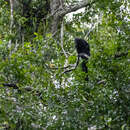mk
имиња во трошки


Pithecia isabela és una espècie de primat del grup dels micos del Nou Món oriünda de l'est del Perú, entre el riu Marañón i el riu Ucayali. Té una llargada total de 76–92 cm i una cua de 40–48 cm. Fou descrita el 2014 en el marc d'una revisió de la taxonomia dels saquis. La part superior de les mans i els peus està coberta de pèls blancs i curts. L'espècie fou anomenada en honor d'Isabel Godin des Odonais.[1]
Pithecia isabela és una espècie de primat del grup dels micos del Nou Món oriünda de l'est del Perú, entre el riu Marañón i el riu Ucayali. Té una llargada total de 76–92 cm i una cua de 40–48 cm. Fou descrita el 2014 en el marc d'una revisió de la taxonomia dels saquis. La part superior de les mans i els peus està coberta de pèls blancs i curts. L'espècie fou anomenada en honor d'Isabel Godin des Odonais.
Der Isabel-Saki (Pithecia isabela) ist eine Primatenart aus der Gruppe der Neuweltaffen, die im östlichen Peru zwischen Río Marañón und Río Ucayali vorkommt. Das relativ kleine Verbreitungsgebiet umfasst in etwa das Gebiet des Naturschutzgebietes Pacaya-Samiria.
Der Isabel-Saki erreicht eine Gesamtlänge von 76 bis 92 cm, der Schwanz hat dabei eine Länge von 40 bis 48 cm. Die Männchen sind schwärzlich gefärbt mit einer hellen Punktierung auf Rücken und Armen und oftmals einem kupferfarbenen Schimmer. Weibchen sind eher dunkel gräulich gefärbt mit bräunlichen Haarspitzen. Bei beiden Geschlechtern sind die Oberseiten der Hände und Füße mit kurzen weißen Haaren bedeckt. Charakteristisch für die Art sind je ein weißer Flecke oberhalb jedes Auges, ein Merkmal, das der Isabel-Saki mit dem Napo-Saki (Pithecia napensis) aus dem ekuadorianischen Amazonasgebiet teilt. Die Flecken stehen beim Napo-Saki jedoch deutlich dichter zusammen, erstrecken sich zusammenfließend bis weit über die Stirn und verlaufen zunehmend vergrauend auch auf das Gesicht, während sie beim Isabel-Saki weitaus kleiner und diffuser ausgeprägt sind und sich auch nicht bis auf das Gesicht erstrecken. Der Napo-Saki wirkt massiger und größer und die Männchen haben eine hellere, mehr orange erscheinende Brust, während die Brust der Männchen des Isabel-Sakis eher orangebraun ist.
Der Isabel-Saki wurde erst 2014 bei einer Revision der Sakis neu beschrieben und zu Ehren von Isabel Godin des Odonais benannt, die im 18. Jahrhundert eine strapaziöse und gefährliche Reise durch das Amazonasgebiet unternahm, um ihren verschollenen Mann, den französischen Naturforscher Jean Godin wiederzufinden. Zuvor waren die Affen dem Äquatorial-Saki (Pithecia aequatorialis) zugeordnet worden.
Der Isabel-Saki (Pithecia isabela) ist eine Primatenart aus der Gruppe der Neuweltaffen, die im östlichen Peru zwischen Río Marañón und Río Ucayali vorkommt. Das relativ kleine Verbreitungsgebiet umfasst in etwa das Gebiet des Naturschutzgebietes Pacaya-Samiria.
Isabel's saki (Pithecia isabela) is a species of saki monkey, a type of New World monkey. It is endemic to a small portion of northern Peru.[2][3]
Populations in this species were formerly classified within the monk saki (P. monachus), but a 2014 study described these populations as a distinct species, P. isabela, based on their distinctive pelage.[4][5] The American Society of Mammalogists, IUCN Red List, and ITIS all follow this classification.[2][3][4][6]
It was named in honor of Isabel Godin des Odonais, an 18th-century Ecuadorian noblewoman who trekked across South America to reunite with her husband.[4]
It is known only from a small portion of northern Peru in the vicinity of the Pacaya-Samiria National Reserve.[4]
This species closely resembles the Napo saki (P. napensis), with both species sharing an overall dark coloration with distinctive white patches above the eyes, but P. napensis also has dense white fur on the forehead, while P. isabela has much more diffuse white fur. P. isabela also has a less extensive, slightly duller orange ruff than P. napensis.[4][7]
This species is thought to be threatened by logging and poaching, as well as its small range, and thus its population is thought to be declining. They are sometimes also found in the pet trade. In addition, numerous tourist lodges have sprung up within the Pacaya-Samiria National Reserve due to increasing ecotourism, and tourist photos indicate that other saki species such as the equatorial saki (P. aequatorialis) and potentially P. napensis have been introduced to these lodges as free-ranging pets; if these animals become established in the wild, they could potentially hybridize with the native P. isabela. However, this species remains poorly-known and it is thus classified as data deficient on the IUCN Red List.[4][6]
Isabel's saki (Pithecia isabela) is a species of saki monkey, a type of New World monkey. It is endemic to a small portion of northern Peru.
Pithecia isabela Marsh, 2014
Pithecia isabela (лат.) — вид приматов из парвотряда широконосые обезьяны.
Этот вид был описан в 2014 году приматологом Лаурой Марш вместе с четырьмя другими видами саки по результатам морфологического анализа имеющихся в распоряжении учёных образцов этих приматов. Результаты были опубликованы в журнале «Neotropical Primates». Видовое название в честь перувийской аристократки колониальных времён Изабелы Одонаис.[1]
Самцы имеют чёрную шерсть с серебристым налётом. Вокруг головы шерсть полностью чёрная. Шерсть вокруг морды у молодняка коричневая, с возрастом темнеет. Кожа на морде чёрная, ладони и ступни белые. Окрас самок схож с окрасом самцов, однако иногда самки имеют медный отлив шерсти. Длина тела от 77 до 92 см, длина хвоста от 40 до 49 см.[2]
Эндемик Перу. Типовой экземпляр был найден у реки Самирия. Имеется свидетельства о встрече этих приматов в районе Укаяли.[2][1]
Pithecia isabela (лат.) — вид приматов из парвотряда широконосые обезьяны.
이사벨사키(Pithecia isabela)는 신세계원숭이에 속하는 사키원숭이의 일종이다. 마라뇬 강과 우카얄리 강 사이의 페루 동부에서 발견된다. 파카야-사미리아 국립 보호 구역의 비교적 좁은 지역에 분포한다.
이사벨사키의 전체 몸길이는 76~92cm, 꼬리 길이는 40~48cm이다. 수컷은 등의 밝은 반점과 함께 거무스레한 색을 띠며, 구릿빛을 희미하게 띠기도 한다. 암컷은 약간 진한 회색을 띠며, 털 끝은 갈색 빛을 보인다. 암수 모두 손 등과 발에 짧은 흰 털이 덮여 있다.[1]